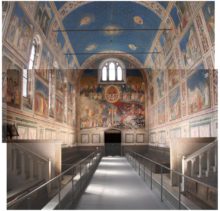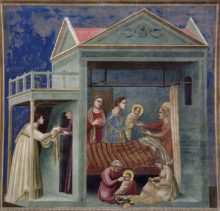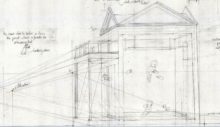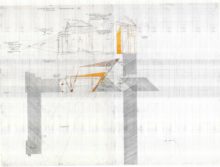The Scrovegni Chapel & the Birth of the Virgin


The Birth of the Virgin is one of the frescoes that decorate the walls of the Scrovegni Chapel in Padua and which will serve as a first case to -literally- draw upon within this research. The frescoes, completed by Giotto di Bondone (c. 1267 – 1337) and his workshop in 1305, are organized in three horizontal strips and represent the lives of Virgin Mary and Christ. On some of the works the scene takes place in a landscape, in others architecture is involved. It is these last ones that are of interest to us. The architectural context that is depicted in The Birth of the Virgin holds the painting together: not only as the compositional foundation, but also as a connector of figures and facilitator of the narrative. The rather peculiar one-room-house envelops no less than three scenes. On the foreground two of the midwives are sitting on the ground around a basin of water, having prepared the cloths and taking care of the infant Mary. Central we see Anna in the bed, reaching out to the nursemaids standing next to her to take over the newborn. At the left, a similar gesture is taking place at the doorway where the bread is being handed from the outside to the inside. Time is not linear. Instead, a sequential viewing is required.
Besides this polyscenic character of the fresco, its Proto-Renaissance representational style is a second intriguing feature that propels this research. Linear one point perspective was yet to be ‘invented’ in the quattrocento, thus Giotto’s pictorial depth was organized by other means. When we prolong the drawn lines, they tend toward different zones, rather than converging at one exact vanishing point. Similar to the previously described plurality of sequences in the narrative, we now encounter a combination of structural spheres in the composition. Looking at it from today’s convention, it may seem distorted, or ‘wrong’. But seen with an open view, this fiction can be perceived as flexible, ambiguous, and full of opportunity. It is exactly this fluidity of context that will enable the perspectival drawing experiments to come about next, where we will address perspective’s generative/spatial potential rather than its representational qualities, and the consequences for our perception.

